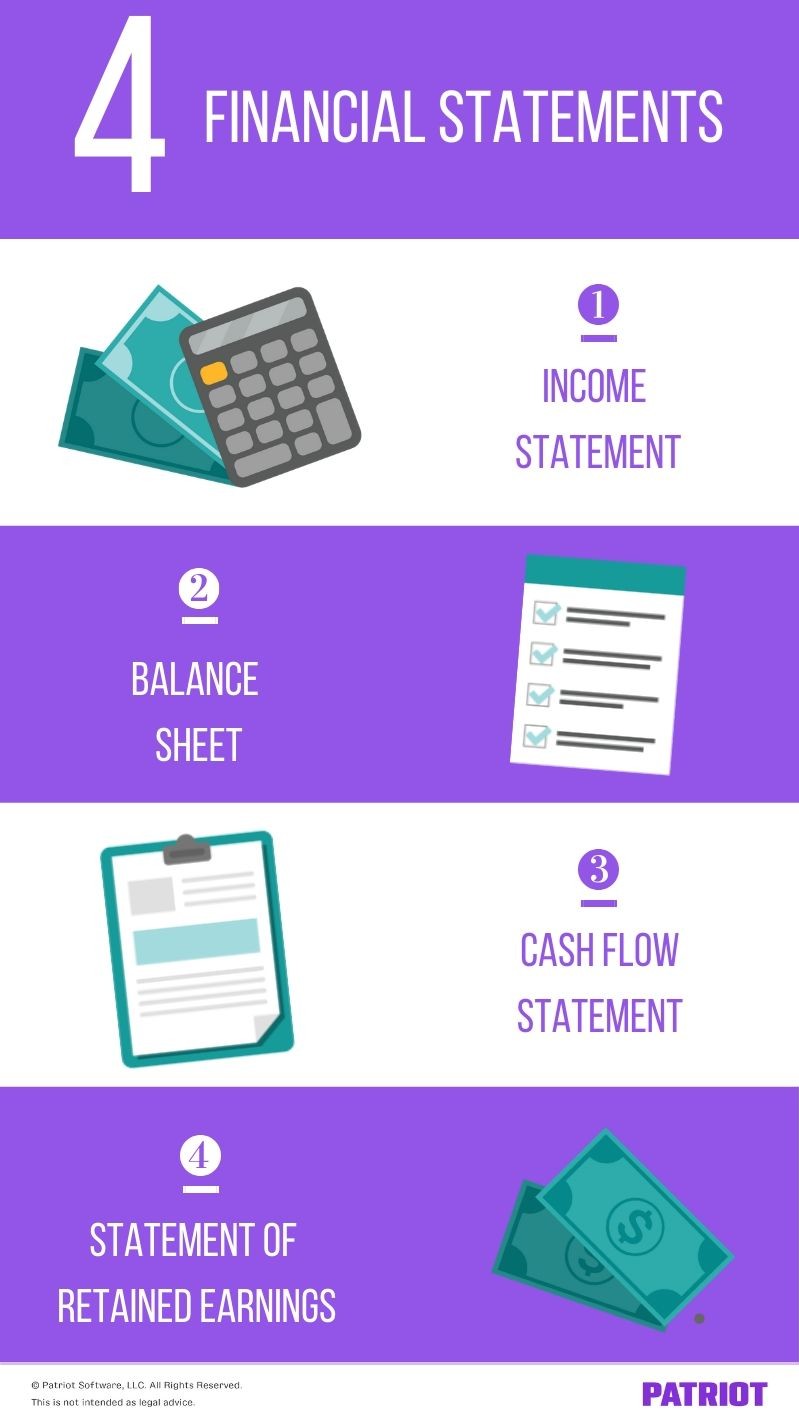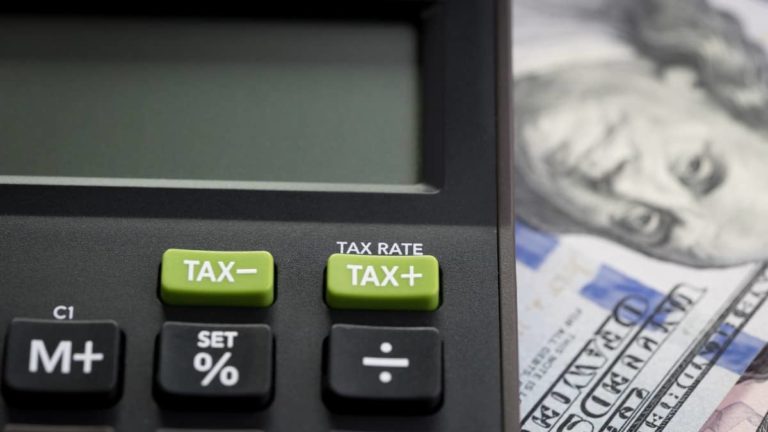If you’re a small business owner, you know how important it is to keep your financial information in order. But to keep your finances organized, you have to know about the four basic financial statements and how you can use them to grow your small business.
What are financial statements?
A financial statement is chock-full of your company’s financial information. You can use your financial statements to get a snapshot of your business’s financial health. Not to mention, you can use statements to organize financial information and come up with a game plan for your business’s financial future.
Your financial statements list things like your expenses and income as well as transaction totals. Each type of financial statement gives you insight into different information.
There are four types of financial statements:
- Income statement
- Balance sheet
- Cash flow statement
- Statement of retained earnings
The four basic financial statements
As a business owner, you must learn the difference between the various accounting financial statements. That way, you know which statements to have handy and what to look for on each of them.
Take a look-see at the different types of financial statements below.

1. Income statement
An income statement, also known as a profit and loss (P&L) statement, shows you your business’s profits and losses over a certain period of time. Your income statement shows you your income and expenses.
You can use an income statement to look at your profits and losses on a weekly, monthly, quarterly, or annual basis.
Use your income statement to see how profitable your business is. Your business’s bottom line (aka the last line of your income statement) shows you whether you have a net income or loss during a specific time frame.
Your income statement can give you a lot of must-have information about your business’s financial status. Income statements can help you:
- Determine expenses you can cut back on
- Measure your financial strengths
- Make financial decisions
- See how much money you have left over
Income statement formats vary from business to business. However, one thing always remains the same: income statements begin with sales and end with net income or loss.
Investors and lenders might want to look at your income statement to see how stable your business’s finances are. After all, they want to make sure your business is healthy before investing in your company.
So, what’s included on an income statement? Here are a few things you might include on yours:
- Revenue or income
- Cost of goods sold
- Gross profit
- Expenses
- Taxes
- Net income or net loss
- Depreciation
- EBIT/EBITDA
- Other financial costs and gains
If you want to assess your business’s profitability during a certain period or see your sales and net income (or loss), checking out your income statement is your best bet.
2. Balance sheet
Your business balance sheet tracks your company’s financial progress and is broken down into three parts:
- Assets
- Liabilities
- Equity
Your assets are your business’s items of value and can be tangible (physical) or intangible (non-physical). Things like cash in your checking account or a company car are examples of assets. Assets can be further broken down into two other categories: current assets (e.g., cash) and noncurrent assets (e.g., property).
Liabilities are debts you owe to individuals, businesses, organizations, and government agencies. Your liabilities can either be long-term (noncurrent) or short-term (current).
Your business’s equity is everything you own in the company minus your liabilities (aka debts). Basically, your equity is your assets minus any liabilities you have.
Each balance sheet’s total assets should always equal your total liabilities and equity. If they don’t balance, track down the cause of the discrepancy.
Balance sheets indicate your company’s current and future financial health. Evaluating your balance sheet can give you an idea of where you stand financially.
Your balance sheet can help you:
- See if your pricing strategy is effective
- Tell if your marketing efforts are working
- Detect spikes in spending
3. Cash flow statement
Your cash flow statement, or statement of cash flows, shows the money that goes in and out of your small business. Cash flow statements only record the actual cash you have.
There are three parts of a cash flow statement:
- Operations
- Investments
- Finances
Your operations measure the incoming and outgoing cash related to your products or services. Operations include things like the money you receive from customers, employee salaries, rent, and other expenses. This section of your cash flow statement tells you whether or not you’re generating enough revenue to keep up with expenses.
The investments portion of your cash flow statement shows purchases or sales of long-term assets. This section can show whether or not your business is growing.
The finances section of your cash flow statement shows how much money is flowing in and out of your business because of loans, dividends, or debts. When you make payments, the money in your finances section decreases.
Cash flow can either be positive or negative. If it’s positive, that means your business has more incoming money than expenses. You have negative cash flow when you spend more money than what you’re earning.
Multiple people (including yourself) might want to analyze your business’s cash flow, such as investors, lenders, and vendors. Your cash flow statement helps determine where your business’s cash flow stands and your company’s overall financial health.
Your statement of cash flows can show you the timing in which money comes in and goes out of your business. By tracking your cash flow, you can create a cash flow forecast and help predict future cash flow.
4. Statement of retained earnings
Your statement of retained earnings lists your business’s retained earnings at the end of a period. So, what are retained earnings? Retained earnings are profits that you can use to invest or pay off liabilities.
You can either add your statement of retained earnings to your balance sheet. Or, you can use your retained earnings statement independently.
The statement of retained earnings might also be known as the statement of owner’s equity, an equity statement, or statement of shareholders’ equity.
Although this statement is not always considered one of the main financial statements, it is still useful for tracking your retained earnings and seeking outside financing.
Create a statement of retained earnings for each accounting period. Keep in mind that your accounting period might be shorter or longer than another business’s period. For example, you might have a monthly accounting period while another company has a quarterly period.
If your statement of retained earnings is positive, you have money to invest in assets for your business or pay off debts.
To set up your statement of retained earnings, use the retained earnings formula. The formula helps you calculate your retained earnings balance at the end of each period.
Check out the retained earnings formula below:
Retained Earnings = Beginning Retained Earnings + Net Income – Dividends Paid
Beginning earnings are the funds you carry over from your previous accounting period. Net income (or loss) is your business’s revenue minus expenses. And, dividends paid is the amount you distribute to your shareholders or owner (if applicable).
Financial statements: Pop quiz!
With so much financial statement information thrown at you at once, it can be difficult to keep up. No worries, there’s still plenty of time to master the basics of financial statements.
Test your knowledge on the four basic financial statements with a mini pop quiz below. And remember, no peeking at the answers!
1. Which statement shows your business’s incoming and outgoing cash?
A. Statement of retained earnings
B. Cash flow forecast
C. Income statement
D. Cash flow statement
2. What are the three parts of a balance sheet?
A. Assets, liabilities, and equity
B. Debt, liabilities, and assets
C. Assets, cash flow, and liabilities
D. Liabilities, equity, and retained earnings
3. Which of the following is not another name for the statement of retained earnings?
A. Statement of shareholders’ equity
B. Shareholders’ statement
C. Equity statement
D. Statement of owner’s equity
4. What statement is also known as a P&L statement?
A. Balance sheet
B. Income statement
C. Cash flow statement
D. Statement of retained earnings
5. Which is not one of the four primary financial statements?
A. Cash flow statement
B. Balance sheet
C. Operations statement
D. Statement of retained earnings
Answers: D, A, B, B, C
Need an easy way to track your business transactions? Patriot’s accounting software makes recording your income and expenses a breeze. Try it for free today!
Like what you read? Let’s connect, friend! Like us on Facebook and let’s get talking.
This is not intended as legal advice; for more information, please click here.







